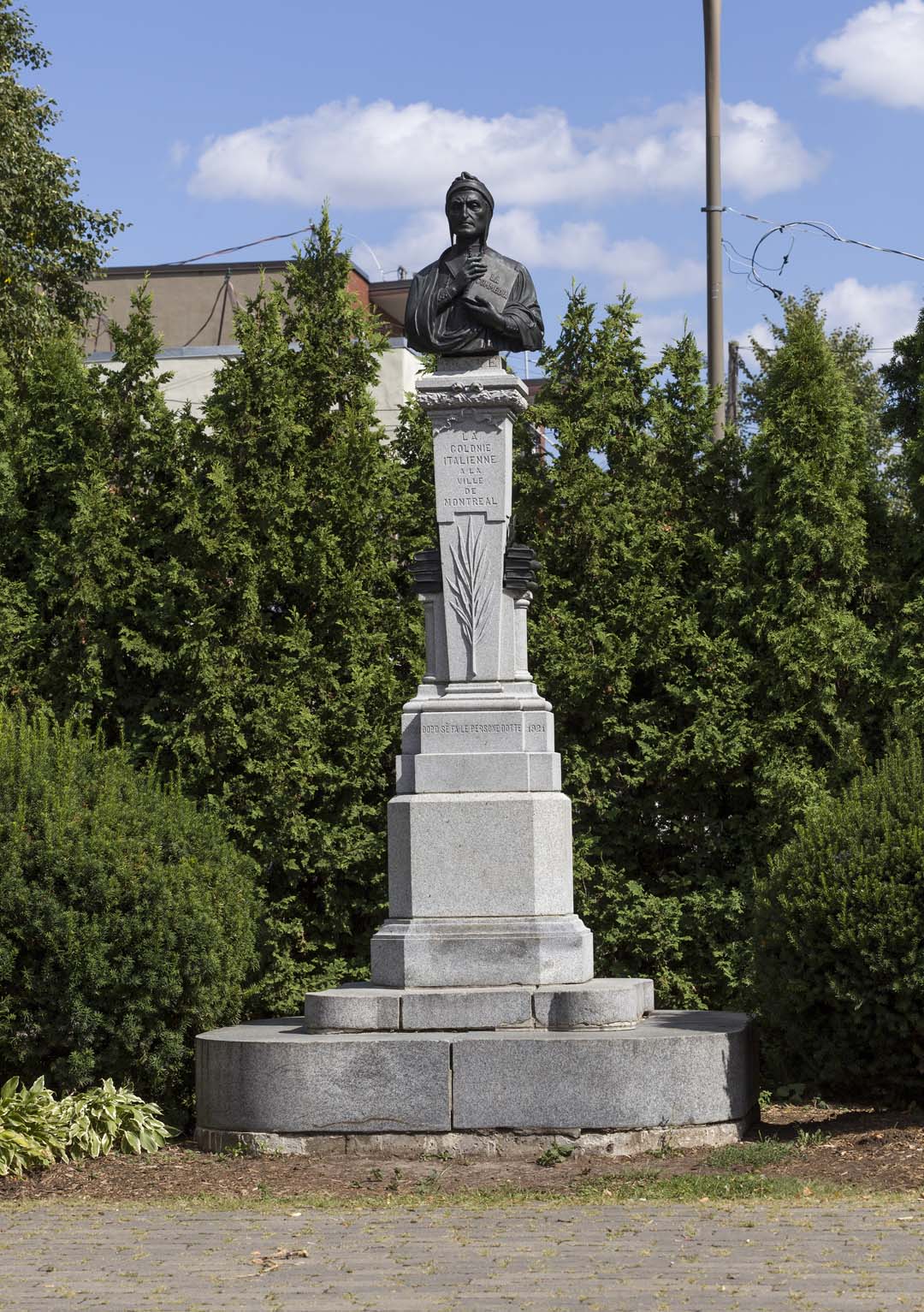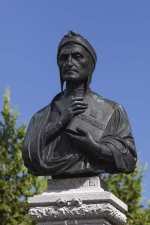Carlo Balboni
La mort de Dante
1921
Presentation of the artwork
Situated in the eponymous park in the heart of Little Italy, this waist-up bust with arms sitting on a tall pedestal, portrays Dante dressed in the style of ancient Rome. He is surrounded by his literary works: he holds La Commedia to his breast, and other books are arranged in piles on small columns on the sides of the pedestal and topped with laurels. The top of the main column is decorated with various ornamentations and its core presents a laurel branch.Although the importance of Dante’s literary oeuvre is never in doubt in the composition of this monument, it is the cultural heritage of an entire country and Italian Montréalers’ sense of belonging to their original culture that are on display. At the time of the inauguration, the president of the committee for the artwork, Cesare Consiglio, summarized the dominant symbolism of the monument to the assembled crowd: “We shall always ardently love our mother country, and you who have fought ... cannot criticize this noble sentiment.” 1
1. Pierre-Georges Roy, “Le buste de Dante Alighieri,” in Les monuments commémoratifs, vol. 2 (Québec City: L. A. Proulx, 1923), p. 337 (our translation).
Associated events
The artwork pays tribute to Durante degli Alighieri, known as Dante, a medieval Florentine poet. Dante wrote La Commedia (The Divine Comedy), a masterpiece of world literature that combines realism and metaphysics in an epic story. He was also a theoretician of popular language and is considered the father of modern Italian.
Presented to the Ville de Montréal by the Italian community on the occasion of the 600th anniversary of Dante’s death, this bust underlines the importance of the Italian cultural heritage in Montréal.
Carlo Balboni
A Montréal sculptor born in Italy, Carlo Balboni (1860–1947) studied sculpture in Italy before moving to Montreal, where he began to have exhibitions at the Art Gallery Association of Montreal in 1909. He worked on the T. Carli house and produced a number of busts, including ones of Benito Mussolini and John Cabot.
Presentation of the artwork
Situated in the eponymous park in the heart of Little Italy, this waist-up bust with arms sitting on a tall pedestal, portrays Dante dressed in the style of ancient Rome. He is surrounded by his literary works: he holds La Commedia to his breast, and other books are arranged in piles on small columns on the sides of the pedestal and topped with laurels. The top of the main column is decorated with various ornamentations and its core presents a laurel branch.Although the importance of Dante’s literary oeuvre is never in doubt in the composition of this monument, it is the cultural heritage of an entire country and Italian Montréalers’ sense of belonging to their original culture that are on display. At the time of the inauguration, the president of the committee for the artwork, Cesare Consiglio, summarized the dominant symbolism of the monument to the assembled crowd: “We shall always ardently love our mother country, and you who have fought ... cannot criticize this noble sentiment.” 1
1. Pierre-Georges Roy, “Le buste de Dante Alighieri,” in Les monuments commémoratifs, vol. 2 (Québec City: L. A. Proulx, 1923), p. 337 (our translation).
Associated events
The artwork pays tribute to Durante degli Alighieri, known as Dante, a medieval Florentine poet. Dante wrote La Commedia (The Divine Comedy), a masterpiece of world literature that combines realism and metaphysics in an epic story. He was also a theoretician of popular language and is considered the father of modern Italian.
Presented to the Ville de Montréal by the Italian community on the occasion of the 600th anniversary of Dante’s death, this bust underlines the importance of the Italian cultural heritage in Montréal.
Carlo Balboni
A Montréal sculptor born in Italy, Carlo Balboni (1860–1947) studied sculpture in Italy before moving to Montreal, where he began to have exhibitions at the Art Gallery Association of Montreal in 1909. He worked on the T. Carli house and produced a number of busts, including ones of Benito Mussolini and John Cabot.






